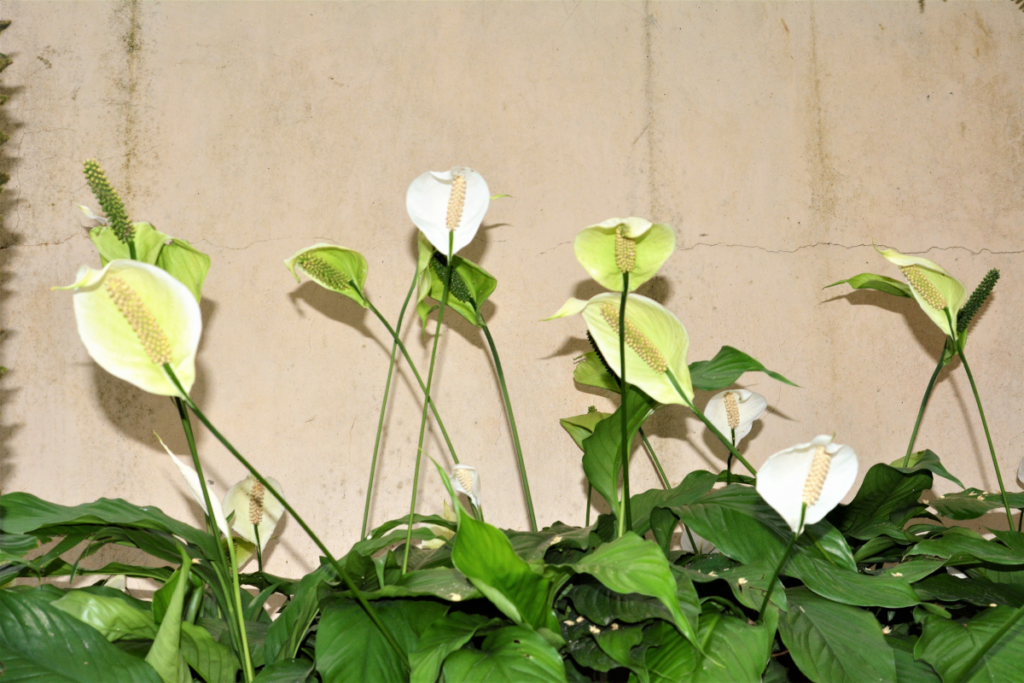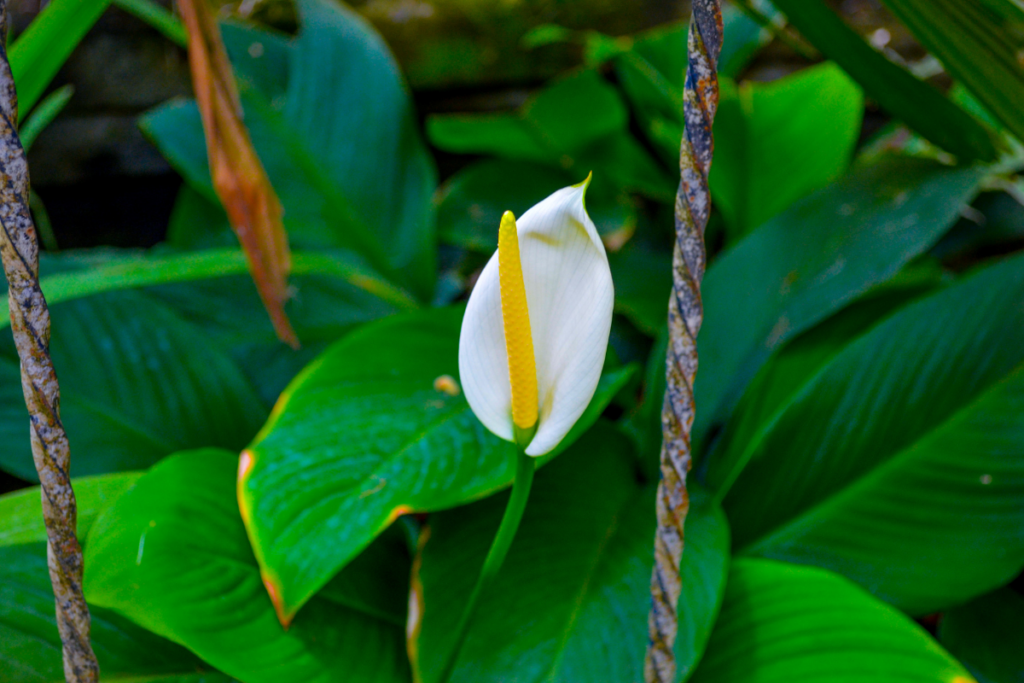Peace lilies are noted for their huge leaves, white, beautiful spathes, tolerance to low light, rich symbolism, and capacity to clear the air. These features are some of the reasons peace lilies are such popular houseplants. Let’s talk about peace lily toxicity.

Nonetheless, you may be concerned about peace lily toxicity if you already own one of these plants or are considering buying one. So, are peace lilies toxic?
All you need to know about peace lilies’ toxicity to people and animals will be discussed in this article.
RELATED: Grow Peace Lilies Outdoors: All the Important Tips and Tricks
Peace Lilies General Overview

The genus Spathiphyllum has a variety of plants known as peace lilies. Peace lilies come in approximately 50 kinds (including variegated variants); however, some are more common as indoor plants than others. The most well-known species is Spathiphyllum cochlearispathum.
All these plants have several long, stemmed leaves that are dark green. Peace lilies also produce white flower spikes with modified bracts known as spathes.
The majority of peace lilies reach heights and widths of between one and four feet. Due to their very simple maintenance requirements, these plants are common indoor plants. During droughts, they can survive under low light conditions as well. However, they like high to moderate humidity.
Are Peace Lily Plants Toxic?
Indeed, all peace lilies can be toxic. As each of these plants belongs to the Araceae family, they are sometimes referred to as arums. This same family of plants also contains philodendrons, calla lilies, monsteras, elephant ears, and anthuriums.
All arums, including all kinds of peace lilies, contain insoluble calcium oxalate crystals. These crystals are present in every part of a peace lily plant, making the whole plant poisonous.
What Happens If Your Pet Chews or Consumes a Peace Lily Plant Part?
The calcium oxalate crystals, which are insoluble, will come into touch with your pet’s mouth if they nibble on a peace lily plant. These crystals resemble microscopic glass shards and may irritate people since they are not insoluble.
Your pet’s mouth will itch if they munch on a peace lily. They may begin drooling or have trouble swallowing as a result, and their mouth or tongue may enlarge.
The plant comes into touch with other bodily parts when your pet ingests it. This could make you throw up. Rarely does swelling become so bad that it affects breathing.
It’s crucial to remember that peace lilies are not genuine lilies and have a very different effect on animals. Although lilies may cause acute kidney failure and toxic to cats, peace lilies do not pose this risk.
Signs of Peace Lily Poisoning
The following are typical symptoms of poisoning in cats brought on by ingesting pieces of frequently growing varieties of peace lily plants, according to the Pet Poison Helpline:
- Mouth Pain
- Excessive Drooling
- Difficulty Swallowing
- Mouth Pawing
- Vomiting
- Diminished appetite
They happen right away when the animal chews on the vegetation.
RELATED: Care For Peace Lily Indoor: Proper Care Guide For Healthier Plants
What Should You Do If Your Pet Is Sick or Has Symptoms?
If you are aware that your pet has gotten into the habit of chewing on a peace lily plant, keep an eye on them and give them water to assist them in spitting it out. Although while signs like mouth sores and drooling often don’t need veterinary attention, you may always contact a vet or a poison control center if you are worried.
A peace lily might make you throw up after eating it. You should get in touch with your veterinarian if your pet keeps throwing up.
Breathing difficulties can sometimes be caused by eating peace lilies. Contact your veterinarian as soon as you detect your pet is having trouble breathing.
Keep an eye on your pet attentively if you notice they’re not feeling well but are unsure of what they’ve been eating. Keep an eye out for things like damaged plants and spilled drinks around your home. For the following steps, get in touch with the poison control center once you know what your pet ate.
Where Can You Get Calcium Oxalate?
The truth is that calcium oxalate may be found almost everywhere in plants that generate the same poison. Yet, only a small number of them really generate significant amounts of this toxin. Crystals of calcium oxalate were discovered in the roots, stems, leaves, flowers, and seeds of certain plants.
As a matter of fact, without even realizing it, you have undoubtedly enjoyed eating other plants that contain oxalic acid, which is the soluble form of oxalate.
As indicated, the irritating calcium oxalate crystals allow plants to protect themselves from being foraged by animals – a great advantage, because they cannot merely run away like other living beings!
It’s interesting to note that these crystals may also develop inside the human body. One of the main components of kidney stones is calcium oxalate. You may likely blame this crystalline chemical component for the agonizing agony connected with passing one of these if you have ever experienced it.
Ways for Preventing Pets from Accessing Peace Lily Plants

If you have a cat or dog that is known to eat plants, you need to take precautions to keep them far from your peace lily. However, most pets will leave commonly grown species of peace lilies alone.
- Physically excluding your dogs from the location where your peace lilies grow is one method. You may lock the door to the sunroom where your plant is, for instance, to keep your dogs out.
- Another option if you have a dog at home is to put the peace lily plant on a tall stand that keeps it out of the dog’s reach. Because of their ability to climb planters, cats normally cannot be used with this technique.
- A peace lily plant’s placement—especially if it’s small—can also be important. Some suggested locations are a high side table, a window sill, or a shelf.
RELATED: How To Save Peace Lily With Brown Leaves: Causes and Essential Fixes
Tips on Growing Peace Lily Plants
Peace lilies may be painful to people as well as being dangerous to animals. Touching the plant’s leaves normally has no negative effects, but getting sap on your skin might hurt.
Using gloves makes sense as a result while working with peace lilies, especially when pruning, repotting, or propagating a peace lily. Thanks to your gloves, you won’t be harmed by the calcium oxalate crystals in the sap of the plant.
Never contact your eyes or lips after touching peace flowers, and always wear gloves. Throw away your gloves when you’ve finished dealing with your plant, then wash your hands.
Other Pet-friendly Houseplants
There are several plants available if you’re seeking for a peace lily substitute that is also suitable for pets. For plant enthusiasts with pets, think about these five pet-friendly houseplants for you.
- Ponytail Palm
The wild leaves on these well-liked indoor palm plants resemble a high ponytail. These palm plants may reach heights of up to eight feet when grown inside, although they often stay lower.
They are excellent for forgetful persons as well since they can withstand dry spells.
- Bromeliads
If you want to add some color to your house or place of business, bromeliad plants could be an excellent option. These tropical plants produce vibrant blooms in a variety of hues, including yellow, pink, and orange.
Nevertheless, keep in mind that these plants thrive from high humidity levels and want their soil to be wet.
- Spider Plant
The spider plant is another sizable plant that is good for pets. These plants may be put on plant stands in addition to hanging baskets, where they perform well.
Long, thin leaves of spider plants may be marketed with stripes or in different colors. On the ends of their leaves, the plants also create miniature planets.
- Boston Fern
The Boston fern, often known as the sword fern, lends rich foliage to any area. It requires little sunlight and little attention, much like the peace lily. Yet, it’s secure for both people and animals.
The places you may put these common indoor plants are also extremely flexible. They look great on a table, in a hanging basket, or on a plant stand.
- Watermelon Peperomia
If you’re searching for a smaller plant that may be placed on your office shelf or coffee table, have a look at the watermelon peperomia. The striped leaves of these plants provide some flair to any setting and are suitable for dogs and cats.
Hope you find our peace lily toxicity information useful. Make sure to check out our other articles:
Are Snake Plants Toxic To Dogs?: Here Are The Answers You Need To Know
Are Succulents Really Toxic and May Hurt Your Innocent Cat or Dog?
What are the Effective Ways to Fix Nitrogen Toxicity in Houseplants?







